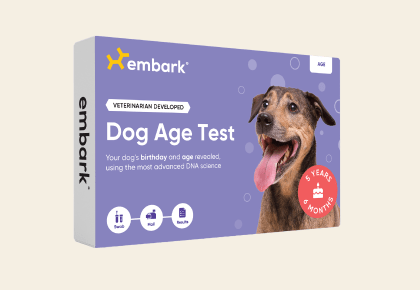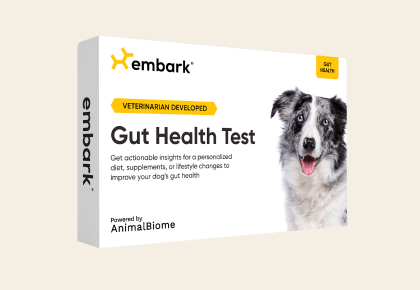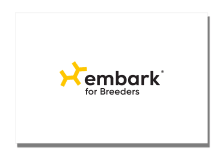Embark for Breeders offers 20 breed-specific genetic health tests for the Labrador Retriever among the 270+ genetic health conditions Embark tests for. Breeders can easily share breed-specific DNA test results on parents or puppies with the one-page DNA Health Summary report with Embark test results.
Genetic health testing is an integral part of a sound dog breeding program. When using genetic health testing, it is important for breeders to educate themselves about concepts such as modes of inheritance, penetrance, prevalence, and phenotype for a specific variant (mutation) in your breed in order to apply test results. Breeders also need to know which variants are causing health concerns in their breed and which health conditions currently have no genetic test available. This handy search function by breed or health condition can show breeders which DNA tests Embark provides.
Embark DNA tests for the Labrador Retriever include the following conditions. The health condition percentages based on clear, carrier, and at-risk status presented on common, rare, and very rare genetic risk factors are based on a subset of dogs within the Embark database and do not necessarily represent all dogs of this breed. While we are not able to provide specific population numbers at this time, we believe the data provided here to be sufficient to inform on current trends within the North American population of Labrador Retrievers.
Common genetic health risk factors <95% clear rate
These are the most common genetic conditions based on Embark data, ranked from most to least prevalent, in the Labrador Retrieve, with less than 95% of dogs testing clear.
Stargardt Disease (ABCA4 Exon 28, Labrador Retriever Variant)
Stargardt Disease is a non-painful inherited degenerative disorder of the rod and cone photoreceptor cells of the retina that results in vision loss. Rods affect vision in the dark, or low light, and cones affect vision in light. As the disease progresses, cone function is profoundly abnormal, whereas rod function is better preserved. Vision slowly deteriorates, but some vision remains throughout an affected dog’s lifetime. The mode of inheritance is recessive.
- Based on Embark-tested Labrador Retrievers that have opted into research, here’s a snapshot of the breed today: 79.1% of dogs tested clear, 18.8% tested carriers, and 1.3% tested at-risk for Stargardt Disease.
Citations: Makelainen et al 2019 Ekesten et al 2022
Exercise-Induced Collapse, EIC (DNM1)
EIC, a muscular disorder, has been linked to a mutation in the DNM1 gene, which codes for the protein dynamin. In the neuron, dynamin trucks neurotransmitter-filled vesicles from the cell body, where they are generated, to the dendrites. It is hypothesized in dogs affected with EIC, the mutation in DNM1 disrupts efficient neurotransmitter release, leading to a cessation in signaling and EIC. The mode of inheritance is recessive.
- Based on Embark-tested Labrador Retrievers that have opted into research, here’s a snapshot of the breed today: 82.1% of dogs tested clear, 16.8% tested carriers, and 0.9% tested at-risk for Exercise-Induced Collapse, EIC (DNM1).
Citations: Patterson et al 2008
Progressive Retinal Atrophy, prcd
PRA-prcd is a retinal disease that causes progressive, non-painful vision loss. The retina contains cells, called photoreceptors, that collect information about light and send signals to the brain. There are two types of photoreceptors: rods, for night vision and movement, and cones, for day vision and color. This type of PRA leads to early loss of rod cells, leading to night blindness before day blindness. The gene is PRCD Exon 1 and the mode of inheritance is recessive.
- Based on Embark-tested Labrador Retrievers that have opted into research, here’s a snapshot of the breed today: 87.5% of dogs tested clear, 11.9% tested carriers, and 0.5% tested at-risk for Progressive Retinal Atrophy, prcd.
Citations: Zangerl et al 2006
Rare genetic health risk factors 95-99% clear rate
These are rare genetic conditions, from lowest to highest, in the Labrador Retriever with from 95% to 99% of dogs testing clear.
Centronuclear Myopathy, CNM (PTPLA)
This muscle disorder is characterized by exercise intolerance, weight loss, and muscle wasting. CNM stems from a mutation in the PTPLA gene which codes for an enzyme important for a number of cellular processes. Loss of PTPLA function is thought to cause muscle fiber damage and death, leading to replacement of the muscle mass with scar tissue.
- Based on Embark-tested Labrador Retrievers that have opted into research, here’s a snapshot of the breed today: 98.2% of dogs tested clear, 0.8% tested carriers, and <0.1% tested at-risk for Hereditary Nasal Parakeratosis, HNPK (SUV39H2).
Citations: Pele et al 2005
Hereditary Nasal Parakeratosis, HNPK (SUV39H2)
This condition causes the skin of the nose to be overly thick and shingle-like, which can be uncomfortable for your dog. The gene is SUV39H2 and affects the skin and connective tissues. The mode of inheritance is recessive.
- Based on Embark-tested Labrador Retrievers that have opted into research, here’s a snapshot of the breed today: 95.5% of dogs tested clear, 4.3% tested carriers, and <0.1% tested at-risk for Hereditary Nasal Parakeratosis, HNPK (SUV39H2).
Citations: Jagannathan et al 2013
Golden Retriever Progressive Retinal Atrophy 2, GR-PRA2 (TTC8)
Golden Retriever PRA 2 is a retinal disease that causes progressive, non-painful vision loss. The retina contains cells, called photoreceptors, that collect information about light and send signals to the brain. There are two types of photoreceptors: rods, for night vision and movement, and cones, for day vision and color. This type of PRA leads to early loss of rod cells, leading to night blindness before day blindness. The gene is TTC8 Exon 8 and the mode of inheritance is recessive.
- Based on Embark-tested Labrador Retrievers that have opted into research, here’s a snapshot of the breed today: 98.6% of dogs tested clear, 1.3% tested carriers, and <0.1% tested at-risk for Golden Retriever Progressive Retinal Atrophy 2, GR-PRA2 (TTC8).
Citations: Downs et al 2013
Skeletal Dysplasia 2, SD2 (COL11A2, Labrador Retriever Variant)
A disease of skeletal development, this causes dogs to have abnormally short legs but similar body lengths compared to unaffected dogs. The gene is COL11A2 and the mode of inheritance is recessive.
- Based on Embark-tested Labrador Retrievers that have opted into research, here’s a snapshot of the breed today: 98.7% of dogs tested clear, 1.2% tested carriers, and <0.1% tested at-risk for Skeletal Dysplasia 2, SD2 (COL11A2, Labrador Retriever Variant).
Citations: Frischknecht et al 2013
Macular Corneal Dystrophy, MCD (CHST6)
This ophthalmologic condition causes abnormal corneal accumulation of complex carbohydrates called glycosaminoglycans. The cornea is the surface of the eye. The gene is CHST6. The mode of inheritance is recessive.
- Based on Embark-tested Labrador Retrievers that have opted into research, here’s a snapshot of the breed today: 98.3% of dogs tested clear, 1.1% tested carriers, and <0.1% tested at-risk for Macular Corneal Dystrophy, MCD (CHST6).
Citations: Tetas Pont 2016
Very rare genetic health risk factors >99% clear rate
The following genetic conditions have a greater than 99% clear rate and are considered very rare genetic diseases in Labrador Retrievers.
Achromatopsia (CNGA3 Exon 7, Labrador Retriever Variant)
Achromatopsia is a progressive, non-painful disorder of the retina that affects color vision and light perception. Cone cells not only register color, they allow the dog to adjust their eyes to bright light. Dogs with this disease constantly feel like us when we step out of a movie theater. Night vision remains completely unaffected. The gene is CNGA3 (Exon 7 Deletion), and the mode of inheritance is recessive.
Citations: Tanaka et al 2015
Alexander Disease (GFAP)
This is a neurological disease that affects the brain and spinal cord. Astrocytes, named for their characteristic star-like shape, are supportive cells of the central nervous system. Astrocytes surround neurons, the functional unit of the central nervous system, nourishing, protecting, and repairing them from stress or injury, as well as enhancing their function. In Alexander disease, astrocyte function is compromised. The gene is GFAP (Exon 4) and the mode of inheritance is dominant.
Citations: Van Poucke et al 2015
Canine Elliptocytosis (SPTB Exon 30)
A benign hematologic disease that affects red blood cell (RBC) shape, elliptocytosis affected dogs have elongated, oval or elliptical red blood cells instead of the normal round, “biconcave” shape. The gene is SPTB Exon 30 and the inheritance type is dominant.
Citations: Di Terlizzi et al 2009
Congenital Myasthenic Syndrome, CMS (COLQ, Labrador Retriever Variant)
This is a non-progressive neuromuscular disease characterized by episodes of exercise intolerance and weakness. The gene is COLQ (Exon 14) and the mode of inheritance is recessive.
Citations: Rinz et al 2014
Degenerative Myelopathy, DM (SOD1A)
The dog equivalent of Amyotrophic Lateral Sclerosis, or Lou Gehrig’s disease, DM is a progressive degenerative disorder of the spinal cord. Because the nerves that control the hind limbs are the first to degenerate, the most common clinical signs are back muscle wasting and gait abnormalities. The gene is SOD1A*, and the mode of inheritance is recessive.
* SOD1A vs SOD1B
Please note: While we test for the SOD1A variant, we do not test for the SOD1B (Bernese Mountain Dog type) variant at this time. Degenerative Myelopathy genotype results apply only to SOD1A.
Citations: Awano et al 2009, Shelton et al 2012, Capuccio et al 2014
Hyperuricosuria and Hyperuricemia or Urolithiasis, HUU (SLC2A9)
This condition causes kidney and bladder stones composed of urate. In most dogs, uric acid is converted to allantoin, an inert substance then excreted in the urine. Dogs with HUU have defects in the pathway that converts uric acid to allantoin. As such, uric acid builds up, crystallizes, and forms urate stones in the kidneys and bladder. Uric acid is an intermediate of purine metabolism. While hyperuricemia in other species (including humans) can lead to painful conditions such as gout, dogs do not develop systemic signs of hyperuricemia. The gene is SLC2A9. This mutation was first described in the Dalmatian. This mutation is inherited in an autosomal recessive manner.
Citations: Bannasch et al 2008 , Karmi et al 2010 , Donner et al 2016
Myotubular Myopathy 1, X-linked Myotubular Myopathy, XL-MTM (MTM1, Labrador Retriever Variant)
This is a degenerative muscle disease that stems from a deficiency in the protein myotubularin, which is thought to be important for the development and maintenance of muscle cells. Loss of myotubularin causes muscle fiber damage and death, leading to the replacement of the muscle mass with scar tissue. The gene is MTM1 (Exon 7) and the mode of inheritance is X-linked recessive.
Citations: Beggs et al 2010
Narcolepsy (HCRTR2 Intron 6, Labrador Retriever Variant)
A neurologic condition, affecting the brain and spinal cord, characterized by daytime sleepiness and fragmented sleep cycles. Affected dogs also exhibit episodes of cataplexy, a sudden complete loss of muscle tone in response to strong positive emotions. All known genetic mutations for canine narcolepsy lie in the Hypocretin receptor 2 (HCRTR2) gene. Hypocretin is a neurotransmitter involved in the regulation of appetite, arousal, and wakefulness. The mode of inheritance is recessive.
Citations: Lin et al 1999
Progressive Retinal Atrophy, crd4/cord1 (RPGRIP1)
PRA-CRD4/cord1 is a retinal disease that causes progressive, non-painful vision loss over a 1-2 year period. The retina contains cells, called photoreceptors, that collect information about light and send signals to the brain. There are two types of photoreceptors: rods, for night vision and movement, and cones, for day vision and color. This type of PRA leads to early loss of cone cells, causing day blindness before night blindness. The gene is RPGRIP1 (Exon 2) and the mode of inheritance is recessive.
Citations: Mellersh et al 2006b
Pyruvate Kinase Deficiency (PKLR Exon 7, Labrador Retriever Variant)
This hematologic disease of red blood cells is characterized by low energy level, jaundiced skin, and pale and cool extremities. Dogs affected with PKD have red blood cells that have impaired ability to produce energy, leading to breakdown of important cell processes that contribute to form and function. The gene is PKLR Exon 7 SNP Variant 1 and the mode of inheritance is recessive.
Citations: Gultekin et al 2012b
Ullrich-like Congenital Muscular Dystrophy (COL6A3 Exon 10, Labrador Retriever Variant)
Ullrich-like Muscular Dystrophy is characterized by progressive muscle weakness, laxity and joint contracture, and respiratory failure. The gene is COL6A3 and the mode of inheritance is recessive.
Citations: Buldoc et al 2020
With 20 known conditions in Labrador Retrievers, this is evidence that genetic disorders are of concern within the breed, and other conditions are likely to be identified in the future. By DNA testing your Labrador Retriever with Embark, you can help accelerate more novel discoveries to help your breed and all dogs.
Canine Health and Breed Resources
Labrador Retriever Club of America
Orthopedic Foundation for Animals (OFA)
OFA Canine Health Information Center (CHIC)
OFA-CHIC Health Testing Requirements for the Labrador Retriever
Mandatory
Hip Dysplasia
Elbow Dysplasia
Eye Examination
EIC (Exercise Induced Collapse) – DNA test
D Locus (Dilute) DNA Test
Optional but recommended
Centronuclear Myopathy – DNA test
Cardiac Evaluation
prcd-PRA DNA Test
Remember, genetic health testing is not a diagnosis of a disease. Please consult your veterinarian for any health issues with your dog. To start your DNA testing journey, explore Embark for Breeders Dog DNA Tests.








